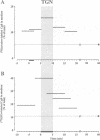Abstract
The role of the single, highly conserved disulfide bond in chromogranin B (secretogranin I) on the sorting of this regulated secretory protein to secretory granules was investigated in the neuroendocrine cell line PC12. Treatment of PC12 cells with dithiothreitol (DTT), a membrane permeable thiol reducing agent known to prevent disulfide bond formation in intact cells, resulted in the secretion of newly synthesized chromogranin B, but only slightly decreased the intracellular storage of newly synthesized secretogranin II, a regulated secretory protein devoid of cysteines. The secretion of newly synthesized chromogranin B in the presence of DTT occurred with similar kinetics to those of a heparan sulfate proteoglycan, a known marker of the constitutive secretory pathway in PC12 cells. Analysis of the various secretory vesicles derived from the trans-Golgi network (TGN) indicated that DTT treatment diverted newly synthesized chromogranin B to constitutive secretory vesicles, whereas the packaging of secretogranin II into immature secretory granules was unaffected by the reducing agent. The chromogranin B molecules diverted to constitutive secretory vesicles, in contrast to those stored in secretory granules, were found to contain free sulfhydryl residues. The effect of DTT on chromogranin B occurred in the TGN rather than in the endoplasmic reticulum. We conclude that the sorting of CgB in the TGN to secretory granules is dependent upon the integrity of its single disulfide bond.
Full text
PDF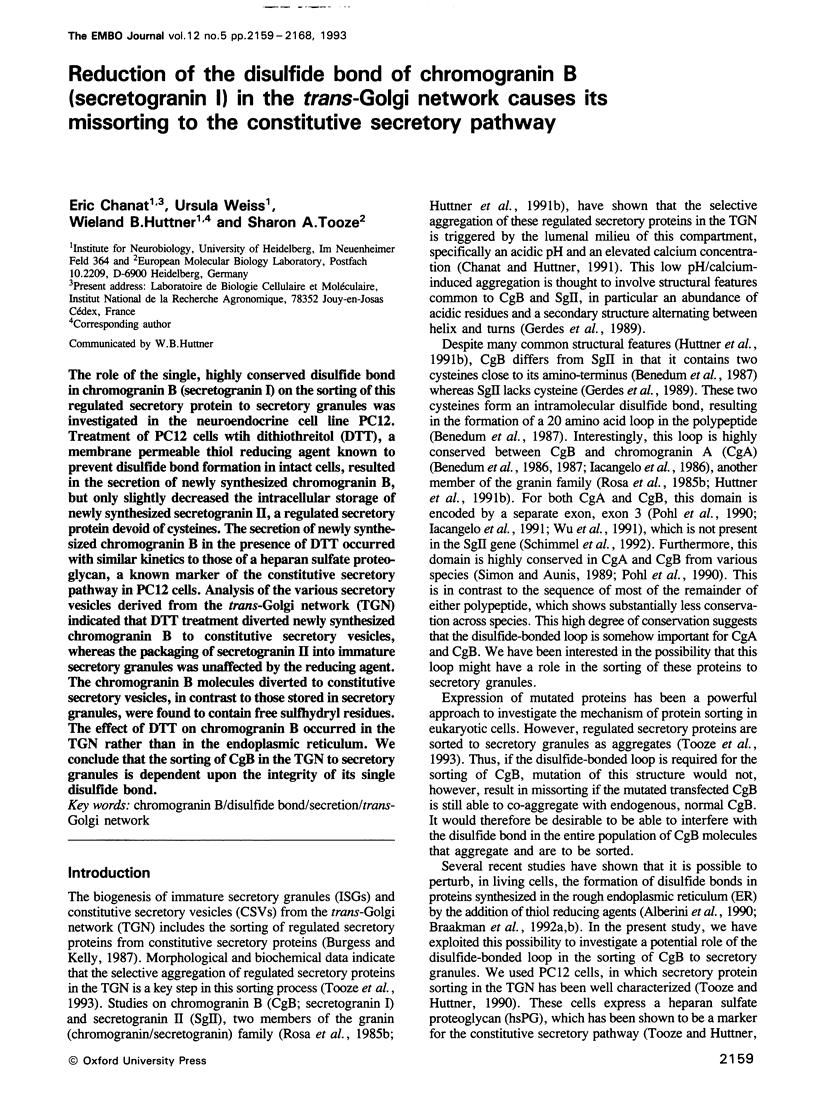
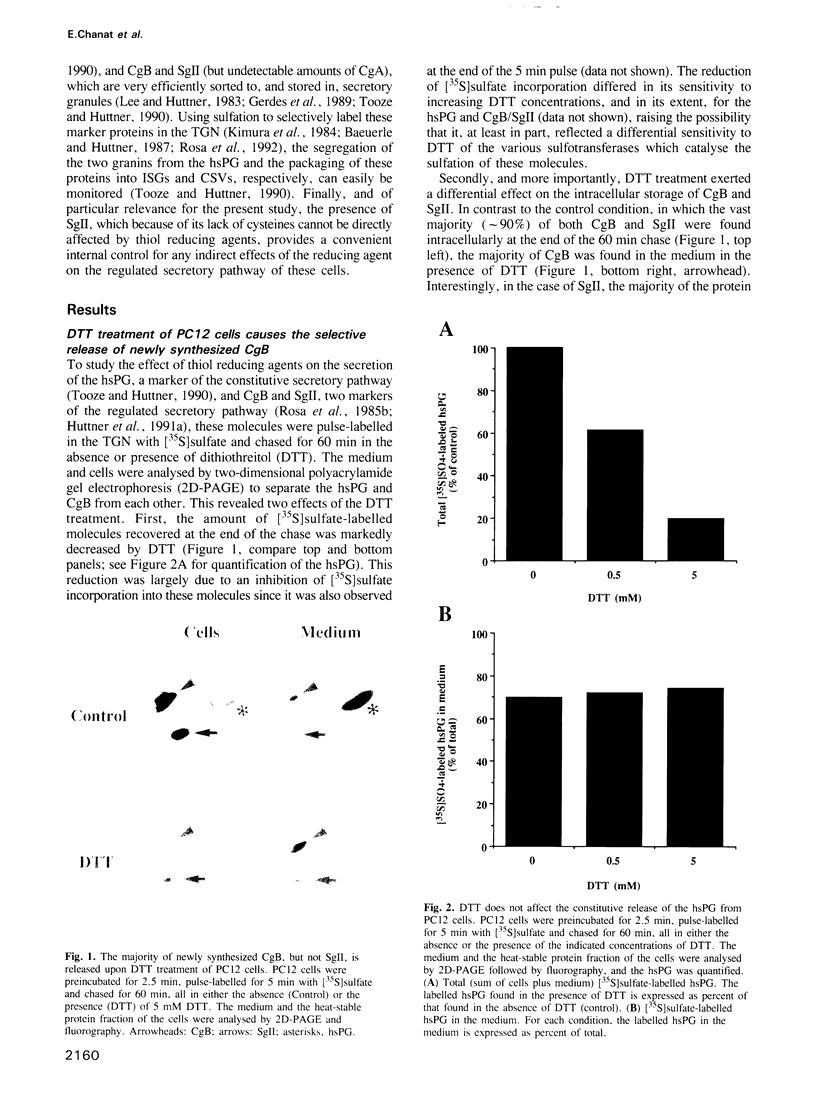
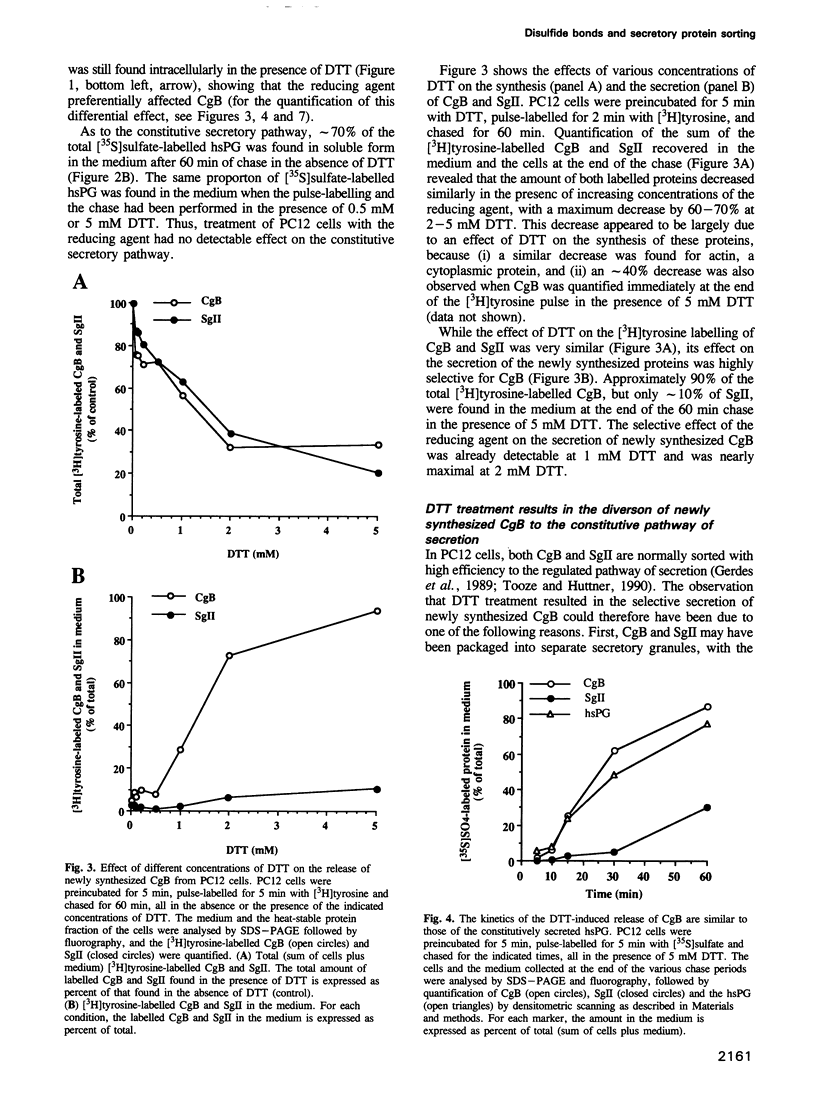
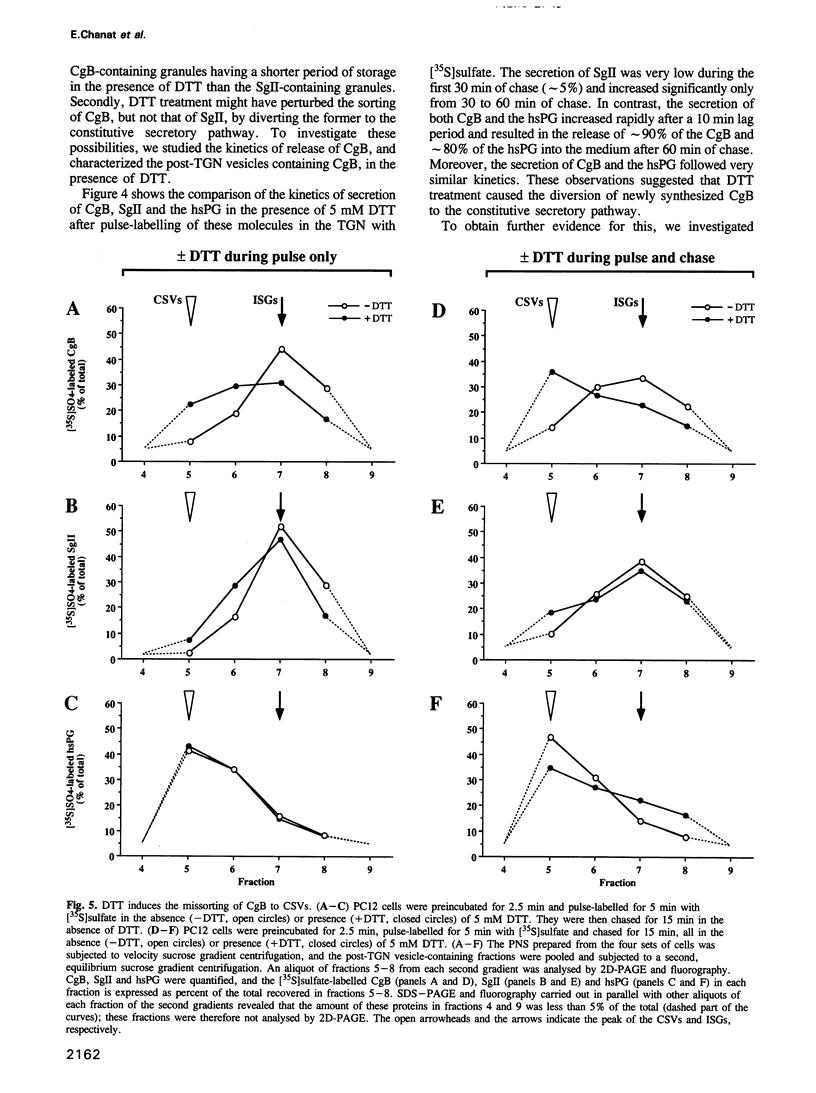
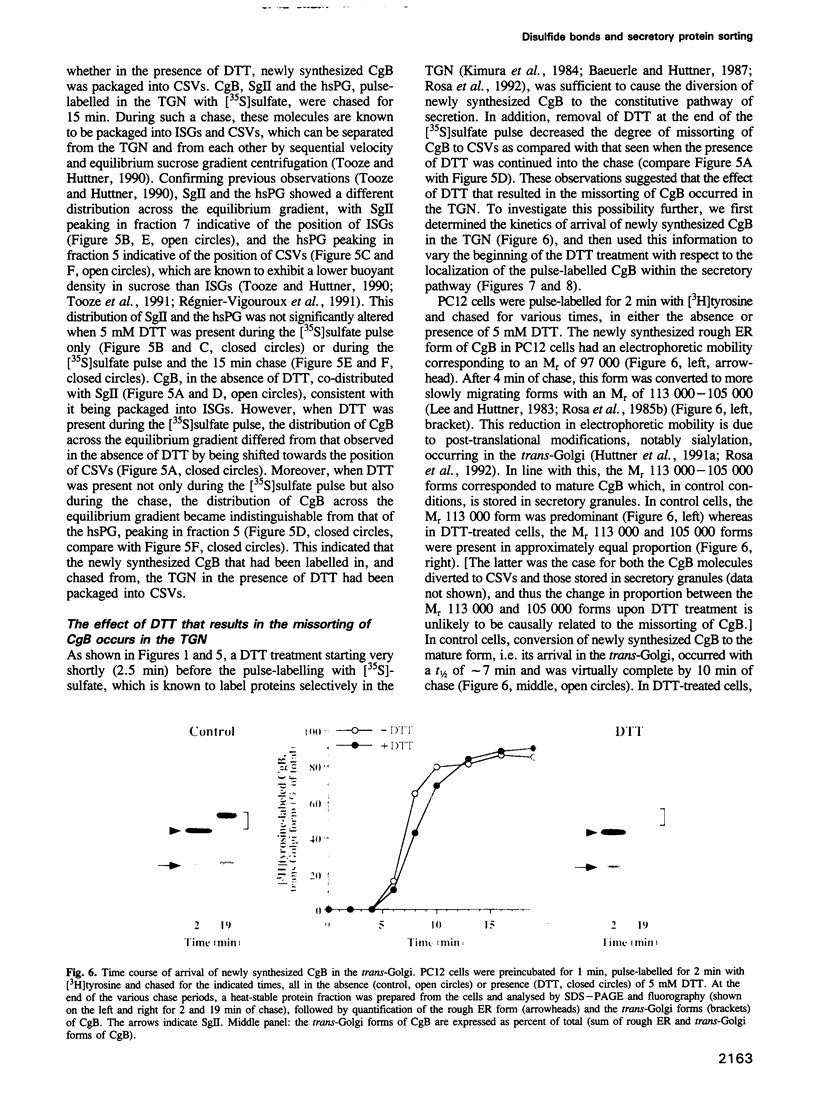
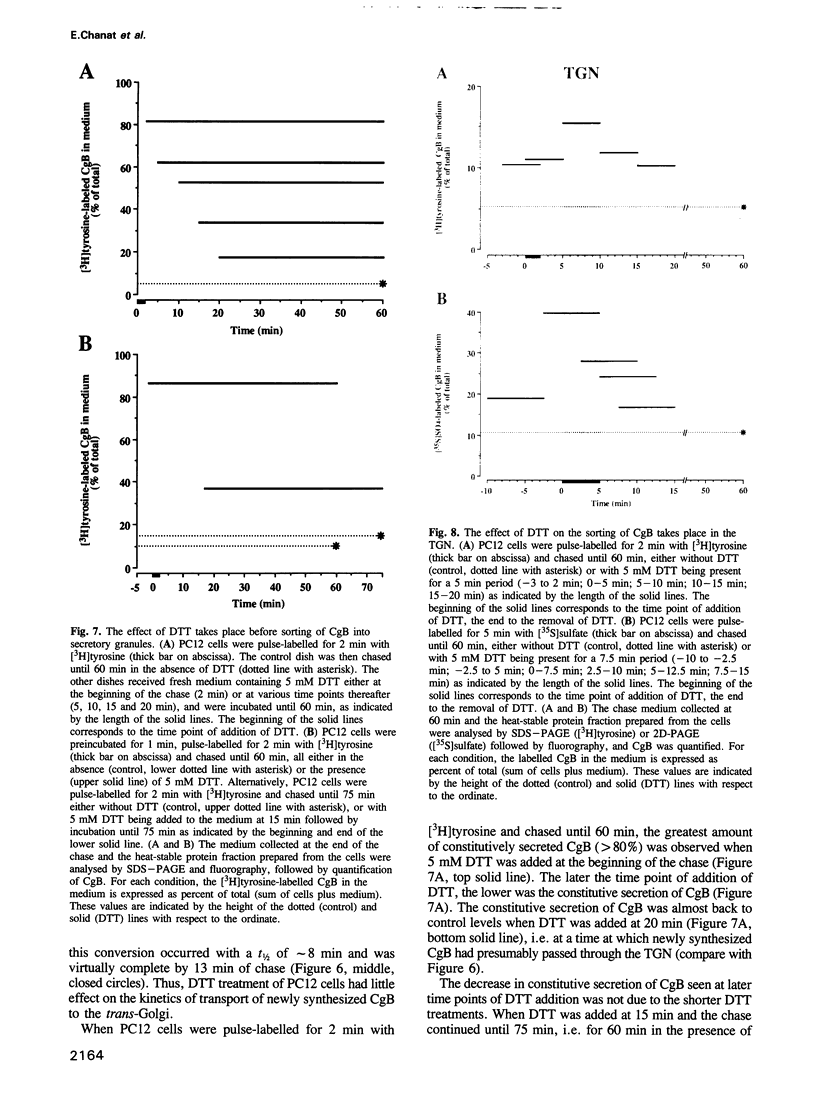
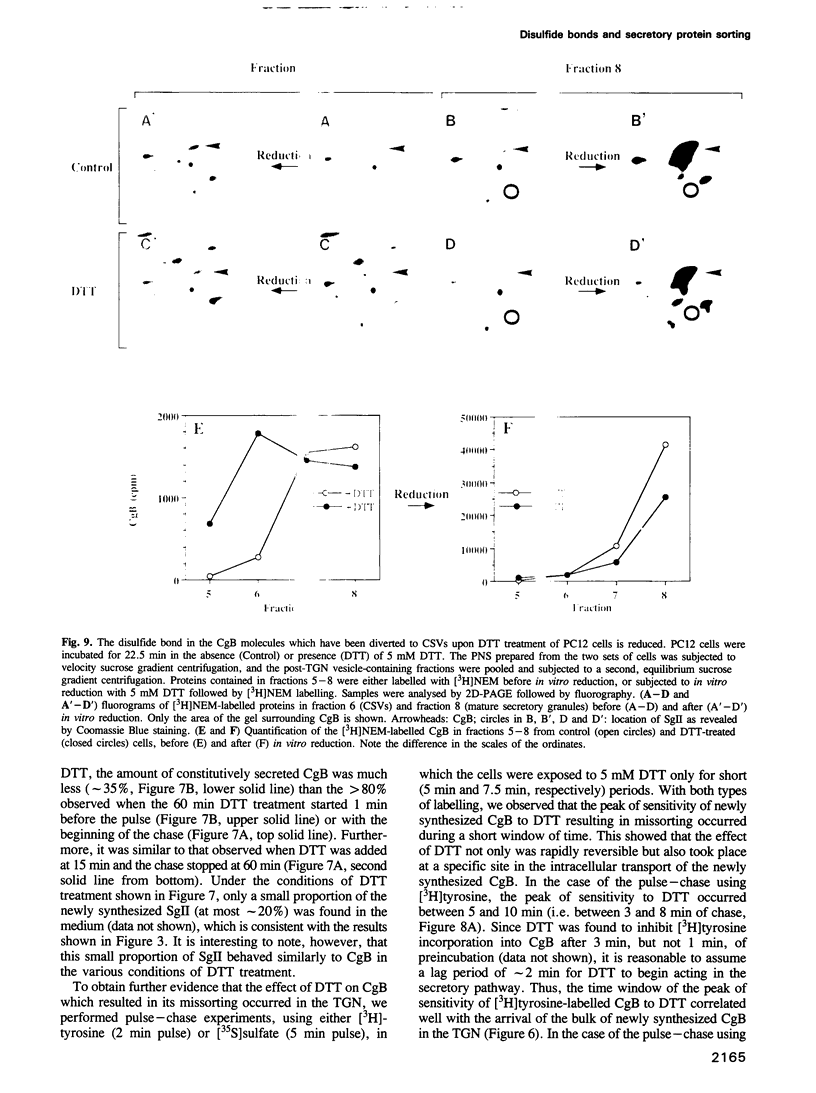
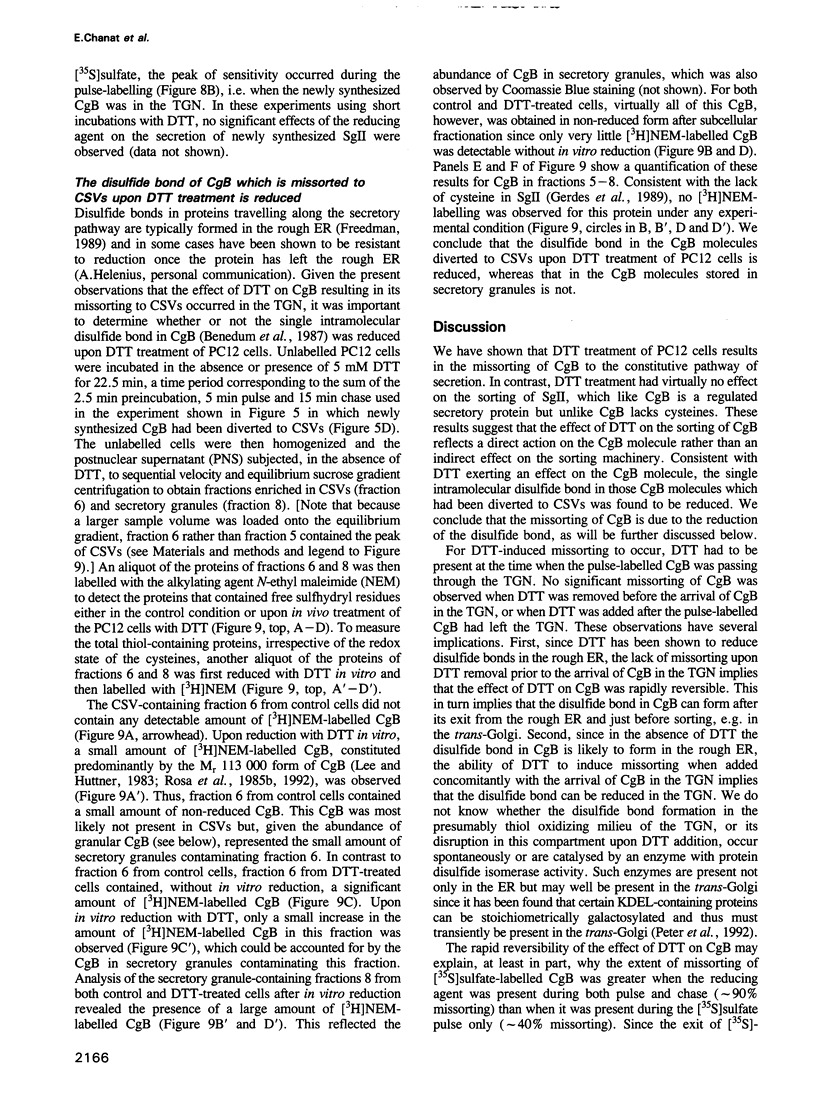
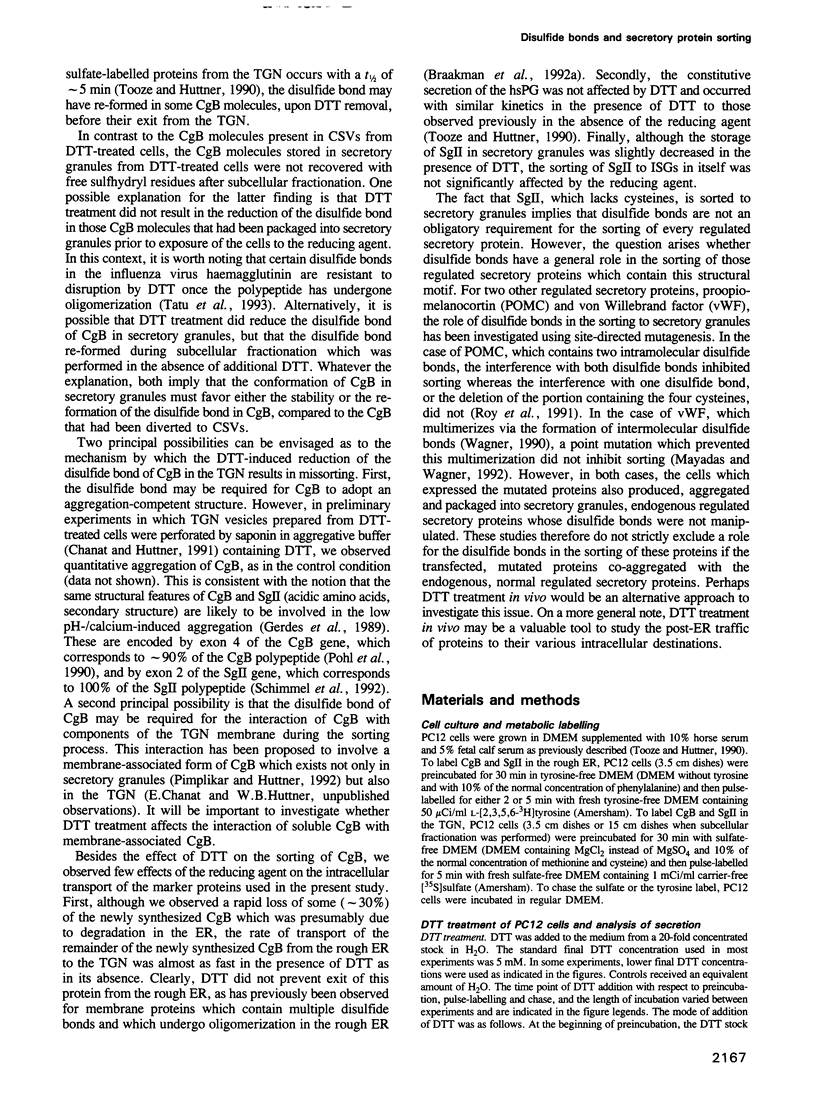
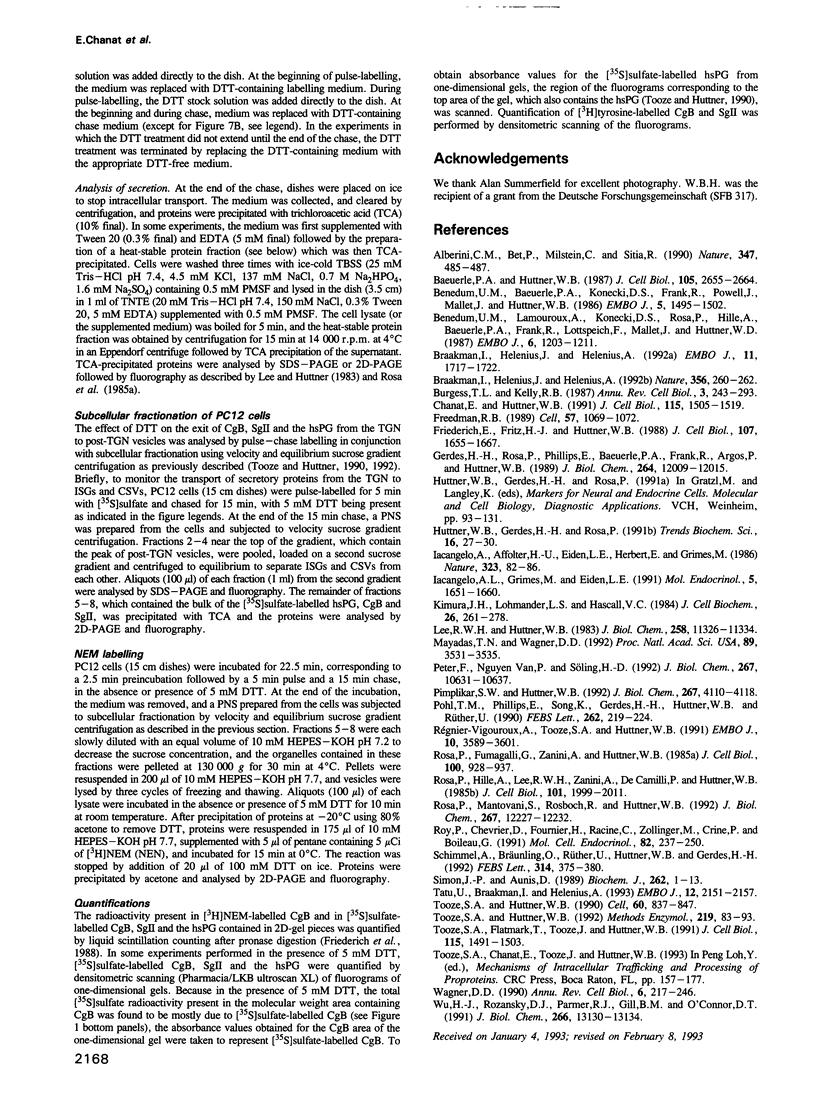
Images in this article
Selected References
These references are in PubMed. This may not be the complete list of references from this article.
- Alberini C. M., Bet P., Milstein C., Sitia R. Secretion of immunoglobulin M assembly intermediates in the presence of reducing agents. Nature. 1990 Oct 4;347(6292):485–487. doi: 10.1038/347485a0. [DOI] [PubMed] [Google Scholar]
- Baeuerle P. A., Huttner W. B. Tyrosine sulfation is a trans-Golgi-specific protein modification. J Cell Biol. 1987 Dec;105(6 Pt 1):2655–2664. doi: 10.1083/jcb.105.6.2655. [DOI] [PMC free article] [PubMed] [Google Scholar]
- Benedum U. M., Baeuerle P. A., Konecki D. S., Frank R., Powell J., Mallet J., Huttner W. B. The primary structure of bovine chromogranin A: a representative of a class of acidic secretory proteins common to a variety of peptidergic cells. EMBO J. 1986 Jul;5(7):1495–1502. doi: 10.1002/j.1460-2075.1986.tb04388.x. [DOI] [PMC free article] [PubMed] [Google Scholar]
- Benedum U. M., Lamouroux A., Konecki D. S., Rosa P., Hille A., Baeuerle P. A., Frank R., Lottspeich F., Mallet J., Huttner W. B. The primary structure of human secretogranin I (chromogranin B): comparison with chromogranin A reveals homologous terminal domains and a large intervening variable region. EMBO J. 1987 May;6(5):1203–1211. doi: 10.1002/j.1460-2075.1987.tb02355.x. [DOI] [PMC free article] [PubMed] [Google Scholar]
- Braakman I., Helenius J., Helenius A. Manipulating disulfide bond formation and protein folding in the endoplasmic reticulum. EMBO J. 1992 May;11(5):1717–1722. doi: 10.1002/j.1460-2075.1992.tb05223.x. [DOI] [PMC free article] [PubMed] [Google Scholar]
- Braakman I., Helenius J., Helenius A. Role of ATP and disulphide bonds during protein folding in the endoplasmic reticulum. Nature. 1992 Mar 19;356(6366):260–262. doi: 10.1038/356260a0. [DOI] [PubMed] [Google Scholar]
- Burgess T. L., Kelly R. B. Constitutive and regulated secretion of proteins. Annu Rev Cell Biol. 1987;3:243–293. doi: 10.1146/annurev.cb.03.110187.001331. [DOI] [PubMed] [Google Scholar]
- Chanat E., Huttner W. B. Milieu-induced, selective aggregation of regulated secretory proteins in the trans-Golgi network. J Cell Biol. 1991 Dec;115(6):1505–1519. doi: 10.1083/jcb.115.6.1505. [DOI] [PMC free article] [PubMed] [Google Scholar]
- Freedman R. B. Protein disulfide isomerase: multiple roles in the modification of nascent secretory proteins. Cell. 1989 Jun 30;57(7):1069–1072. doi: 10.1016/0092-8674(89)90043-3. [DOI] [PubMed] [Google Scholar]
- Friederich E., Fritz H. J., Huttner W. B. Inhibition of tyrosine sulfation in the trans-Golgi retards the transport of a constitutively secreted protein to the cell surface. J Cell Biol. 1988 Nov;107(5):1655–1667. doi: 10.1083/jcb.107.5.1655. [DOI] [PMC free article] [PubMed] [Google Scholar]
- Gerdes H. H., Rosa P., Phillips E., Baeuerle P. A., Frank R., Argos P., Huttner W. B. The primary structure of human secretogranin II, a widespread tyrosine-sulfated secretory granule protein that exhibits low pH- and calcium-induced aggregation. J Biol Chem. 1989 Jul 15;264(20):12009–12015. [PubMed] [Google Scholar]
- Huttner W. B., Gerdes H. H., Rosa P. The granin (chromogranin/secretogranin) family. Trends Biochem Sci. 1991 Jan;16(1):27–30. doi: 10.1016/0968-0004(91)90012-k. [DOI] [PubMed] [Google Scholar]
- Iacangelo A. L., Grimes M., Eiden L. E. The bovine chromogranin A gene: structural basis for hormone regulation and generation of biologically active peptides. Mol Endocrinol. 1991 Nov;5(11):1651–1660. doi: 10.1210/mend-5-11-1651. [DOI] [PubMed] [Google Scholar]
- Iacangelo A., Affolter H. U., Eiden L. E., Herbert E., Grimes M. Bovine chromogranin A sequence and distribution of its messenger RNA in endocrine tissues. Nature. 1986 Sep 4;323(6083):82–86. doi: 10.1038/323082a0. [DOI] [PubMed] [Google Scholar]
- Kimura J. H., Lohmander L. S., Hascall V. C. Studies on the biosynthesis of cartilage proteoglycan in a model system of cultured chondrocytes from the Swarm rat chondrosarcoma. J Cell Biochem. 1984;26(4):261–278. doi: 10.1002/jcb.240260406. [DOI] [PubMed] [Google Scholar]
- Lee R. W., Huttner W. B. Tyrosine-O-sulfated proteins of PC12 pheochromocytoma cells and their sulfation by a tyrosylprotein sulfotransferase. J Biol Chem. 1983 Sep 25;258(18):11326–11334. [PubMed] [Google Scholar]
- Mayadas T. N., Wagner D. D. Vicinal cysteines in the prosequence play a role in von Willebrand factor multimer assembly. Proc Natl Acad Sci U S A. 1992 Apr 15;89(8):3531–3535. doi: 10.1073/pnas.89.8.3531. [DOI] [PMC free article] [PubMed] [Google Scholar]
- Peter F., Nguyen Van P., Söling H. D. Different sorting of Lys-Asp-Glu-Leu proteins in rat liver. J Biol Chem. 1992 May 25;267(15):10631–10637. [PubMed] [Google Scholar]
- Pimplikar S. W., Huttner W. B. Chromogranin B (secretogranin I), a secretory protein of the regulated pathway, is also present in a tightly membrane-associated form in PC12 cells. J Biol Chem. 1992 Feb 25;267(6):4110–4118. [PubMed] [Google Scholar]
- Pohl T. M., Phillips E., Song K. Y., Gerdes H. H., Huttner W. B., Rüther U. The organisation of the mouse chromogranin B (secretogranin I) gene. FEBS Lett. 1990 Mar 26;262(2):219–224. doi: 10.1016/0014-5793(90)80194-n. [DOI] [PubMed] [Google Scholar]
- Rosa P., Fumagalli G., Zanini A., Huttner W. B. The major tyrosine-sulfated protein of the bovine anterior pituitary is a secretory protein present in gonadotrophs, thyrotrophs, mammotrophs, and corticotrophs. J Cell Biol. 1985 Mar;100(3):928–937. doi: 10.1083/jcb.100.3.928. [DOI] [PMC free article] [PubMed] [Google Scholar]
- Rosa P., Hille A., Lee R. W., Zanini A., De Camilli P., Huttner W. B. Secretogranins I and II: two tyrosine-sulfated secretory proteins common to a variety of cells secreting peptides by the regulated pathway. J Cell Biol. 1985 Nov;101(5 Pt 1):1999–2011. doi: 10.1083/jcb.101.5.1999. [DOI] [PMC free article] [PubMed] [Google Scholar]
- Rosa P., Mantovani S., Rosboch R., Huttner W. B. Monensin and brefeldin A differentially affect the phosphorylation and sulfation of secretory proteins. J Biol Chem. 1992 Jun 15;267(17):12227–12232. [PubMed] [Google Scholar]
- Roy P., Chevrier D., Fournier H., Racine C., Zollinger M., Crine P., Boileau G. Investigation of a possible role of the amino-terminal pro-region of proopiomelanocortin in its processing and targeting to secretory granules. Mol Cell Endocrinol. 1991 Dec;82(2-3):237–250. doi: 10.1016/0303-7207(91)90037-s. [DOI] [PubMed] [Google Scholar]
- Régnier-Vigouroux A., Tooze S. A., Huttner W. B. Newly synthesized synaptophysin is transported to synaptic-like microvesicles via constitutive secretory vesicles and the plasma membrane. EMBO J. 1991 Dec;10(12):3589–3601. doi: 10.1002/j.1460-2075.1991.tb04925.x. [DOI] [PMC free article] [PubMed] [Google Scholar]
- Schimmel A., Bräunling O., Rüther U., Huttner W. B., Gerdes H. H. The organisation of the mouse secretogranin II gene. FEBS Lett. 1992 Dec 21;314(3):375–380. doi: 10.1016/0014-5793(92)81509-k. [DOI] [PubMed] [Google Scholar]
- Simon J. P., Aunis D. Biochemistry of the chromogranin A protein family. Biochem J. 1989 Aug 15;262(1):1–13. doi: 10.1042/bj2620001. [DOI] [PMC free article] [PubMed] [Google Scholar]
- Tatu U., Braakman I., Helenius A. Membrane glycoprotein folding, oligomerization and intracellular transport: effects of dithiothreitol in living cells. EMBO J. 1993 May;12(5):2151–2157. doi: 10.1002/j.1460-2075.1993.tb05863.x. [DOI] [PMC free article] [PubMed] [Google Scholar]
- Tooze S. A., Flatmark T., Tooze J., Huttner W. B. Characterization of the immature secretory granule, an intermediate in granule biogenesis. J Cell Biol. 1991 Dec;115(6):1491–1503. doi: 10.1083/jcb.115.6.1491. [DOI] [PMC free article] [PubMed] [Google Scholar]
- Tooze S. A., Huttner W. B. Cell-free formation of immature secretory granules and constitutive secretory vesicles from trans-Golgi network. Methods Enzymol. 1992;219:81–93. doi: 10.1016/0076-6879(92)19012-u. [DOI] [PubMed] [Google Scholar]
- Tooze S. A., Huttner W. B. Cell-free protein sorting to the regulated and constitutive secretory pathways. Cell. 1990 Mar 9;60(5):837–847. doi: 10.1016/0092-8674(90)90097-X. [DOI] [PMC free article] [PubMed] [Google Scholar]
- Wagner D. D. Cell biology of von Willebrand factor. Annu Rev Cell Biol. 1990;6:217–246. doi: 10.1146/annurev.cb.06.110190.001245. [DOI] [PubMed] [Google Scholar]
- Wu H. J., Rozansky D. J., Parmer R. J., Gill B. M., O'Connor D. T. Structure and function of the chromogranin A gene. Clues to evolution and tissue-specific expression. J Biol Chem. 1991 Jul 15;266(20):13130–13134. [PubMed] [Google Scholar]





